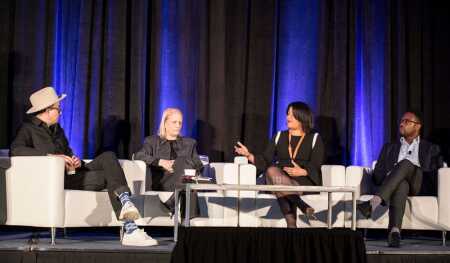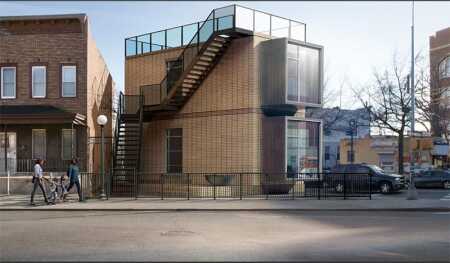Could ownership of 250- to 400-square-foot (23 to 37 sq m) homes help low-income people acquire an asset and begin to accrue wealth?
Definitely, said the Rev. Faith Fowler, director of Cass Community Social Services, speaking at the 2018 ULI Spring Meeting in Detroit. The Detroit-based organization is building 25 tiny homes near its campus—houses not simply for shelter but for homeownership.
“Ours is a rent-then-own program,” Fowler said. Participants pay $1 per square foot ($11 per sq m) for rent, he said. “They work with the program for seven years, volunteer in the community, join the homeowners association, and work with a financial coach,” he said. “After seven years—provided they have paid their rent each month—the home is theirs. They can then continue living in it and accrue equity, sell it, or give it to a family member. It’s their decision.”
Spring Meeting Resources: Download the presentation.
The Cass Community Social Services program was one of the innovative housing solutions presented during a panel moderated by Tom Murphy, ULI senior resident fellow and Joseph C. Canizaro/Klingbell Family Chair for Urban Development.
Murphy noted that most of the wealth in low-income and minority households is derived from housing. Affordable homeownership opportunities could be a critical component of place-based community development initiatives that lead to wealth creation in revitalizing cities, he said. This is different from most affordable housing strategies, he emphasized, because these initiatives offer individuals the opportunity to purchase property and increase their wealth.
Jeff Wilson, founder of Austin-based micro-housing company Kasita, offers a different option. Wilson’s three-year-old company provides a product—homes with 400 square feet (37 sq m) of space—for areas where housing is in high demand.
“The idea is to build something in a factory of super-high design and high tolerance while still being attainable,” he said. “We can make one of these in four weeks and ship it anywhere in the country. Part of our strategy is for use in dense urban areas where you might find an irregular plot of land.”
The units can be stacked up to ten stories high; already a developer in New York is eyeing Kasitas for a few hundred lots—most of them of irregular shapes—that he has bought in the area, Wilson said.
“He’s been able to buy the lots way under market and he can go and drop these Kasitas all over the city and rent them out or sell them,” said Wilson. “There is a developer outside Austin who is talking about using the product in a ‘micro-estate’ development.” The average price of a home in Austin is $400,000, Wilson said. “A person could build equity in a Kasita, which starts at $89,000 for a 400-square-foot home.”

From left to right: Jeff Wilson, founder of Austin-based micro-housing company Kasita; the Rev. Faith Fowler, director of Cass Community Social Services; Tosha Tabron, vice president/relationship manager, global philanthropy, JP Morgan & Chase Co.; and David Alade, cofounder and managing partner of Detroit-based Century Partners, speaking on a panel at the 2018 ULI Spring Meeting in Detroit.
In Detroit, as the city continues to climb back from bankruptcy, JPMorgan Chase has made a $150 million commitment to the area, which has an estimated 95,000 blighted houses in need of attention, said Tosha M. Tabron, vice president/relationship manager, global philanthropy, at the company.
“The city had an auction program where you could buy a house for a $1,000, but the home might need $30,000 in repairs,” she said. “Some people saw the opportunity of buying a home for $1,000 but didn’t know all the expenses that came with it. Our job as a large organization is to work and put money into things like downpayment assistance—to help people and also scale up companies. It’s hard to get talent to build out what we have. We need to get more minority contractors and create opportunities for them.”
She added that besides revitalizing neighborhoods, philanthropic organizations and others must work to strengthen the city’s infrastructure.
“We have to create jobs for Detroiters so they can enjoy owning a home,” she said. “People can’t live on $15,000 a year. We want people’s income to increase. We want to create jobs and create livable communities at the same time. We want a strong economic engine.”
David Alade, cofounder and managing partner of Detroit-based Century Partners, a neighborhood-focused real estate firm that manages the rehabilitation of historic and dilapidated homes in Detroit, said he moved from New York to Detroit “because we thought we could develop a little bit differently. We thought Detroit was unique because it has a high percentage of homeownership for folks of color and its neighborhoods are strong. We carried our strategy to three neighborhoods.” The company’s next focus is Detroit’s Fitzgerald neighborhood, where it plans to buy and activate 300 parcels of land.
Alade said Detroit is a very interesting housing market. “You have some houses selling for $5,000, and one block north homes are selling for $125,000,” he said.
“Detroit is the place where the American dream was realized,” he said. “We have an opportunity to help people and revitalize the neighborhoods.”
What caught the fancy of the audience, though, was Cass’s tiny homes. “This is a chance for people who never owned a home to own one,” said Fowler. “It is a chance of a lifetime.”
The tiny homes cost $45,000 to $50,000 to build and are aimed at people who make $7,000 and $9,000 a year. Organizations such as General Motors have contributed to the effort, which helps keep material costs down, he said.
“Our vetting is pretty serious, and we make sure they have a job and earn $7,000–$8,000 a year,” Fowler said of the residents. “Residents are a diverse group, including formerly homeless people, senior citizens, and college students. They all must take housing classes where they all come together and are taught how to engage a contractor, when to change the air filter, and so forth. If you’ve never owned before, you don’t know what you don’t know.”
Each home will be on its own 30-by-100-foot (9 by 30 m) lot, and each will be on a foundation. Most will have a front porch or backyard to increase the living space.





